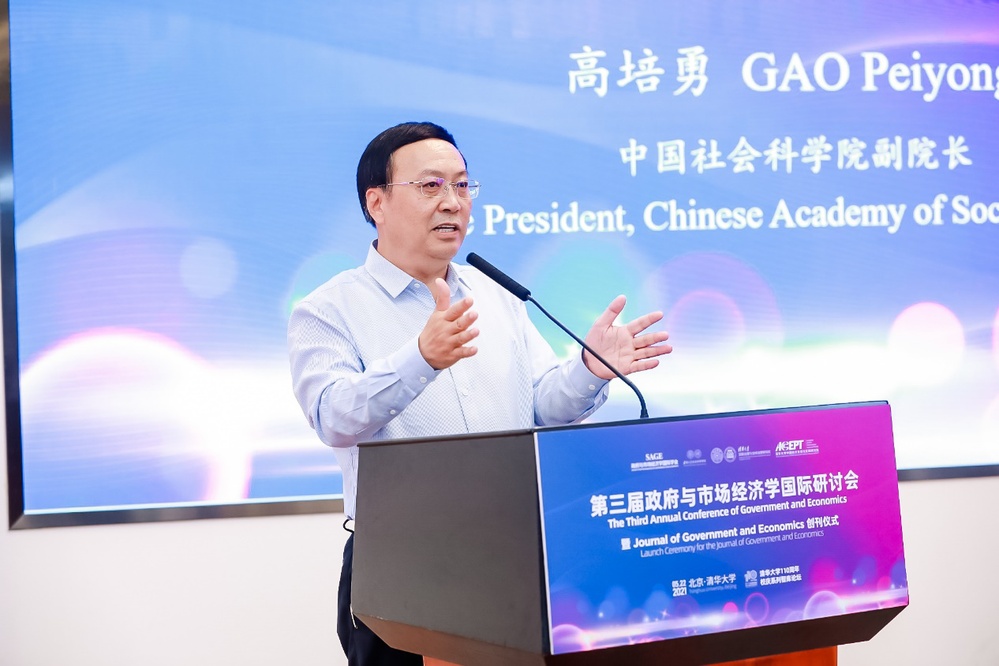Gao Peiyong: Changes in the Government-Market Relationship Due to the Pandemic
The following is a translation of Gao Peiyong's speech on May 22, 2021 at the Third Annual Conference of Government and Economics. Gao Peiyong is a Vice President of the Chinese Academy of Social Sciences.

Today we gather here for the Third Annual Conference of Government and Economics. I think one issue that certainly comes to mind is whether any changes have taken place in the relationship between the government and the market in China through the trials and tribulations of the pandemic. If so, what sort of changes?
When we speak of such changes, we always compare them to the government-market relationship before the pandemic, using this as a frame of reference. Let’s look back on last year and on these first five months of 2021 to track the clues that can illustrate the changing government-market relationship, carefully capturing the changes that have taken place. Different people may come to varying conclusions about these changes from different perspectives. From my perspective, one of the critical angles for observation is the configuration of macroeconomic policies. Though we may observe the changes from varying angles, I would like to begin with the configuration of macroeconomic policies.
From a macroeconomic policy perspective, what exactly are the fundamental or major changes that have taken place in the nearly one and a half years from 2020 to this point in 2021? Judging from my analysis, one vital change is that policymakers have increasingly shifted their focus to market entities, viewing them as the basis and starting point for policymaking. There are several reasons for this. First and foremost, the priority tasks of China’s economic work in 2020 are embodied in the “six guarantees” and “six stabilities.”
In fact, these areas were the focus of all the economic work and macroeconomic policies rolled out in 2020, and the priorities remain the same for 2021. I believe everyone here is quite familiar with the “six guarantees” and “six stabilities,” but we must dig deeper to identify the logical clues hidden behind the terms.
We often talk about the “six guarantees.” However, these six guarantees do not share the same stage, but rather have varying levels of importance. Among the six guarantees, the top three are the most important—namely, guaranteeing employment, the basic livelihood of the people, and the operation of market entities. Among the top three guarantees, safeguarding the operations of market entities is regarded as the priority. This is because only by safeguarding the operations of market entities can we safeguard employment. In the absence of market entities, we cannot speak of employment, and without the guarantee of employment, we cannot guarantee people’s livelihood. In the absence of employment, no income can be generated to improve people’s livelihood. Thus, only when the first three guarantees are achieved can the foundation of the Chinese economy be secured, and only then can industrial and supply chain security, food and energy security, and normal grassroots operations be guaranteed.
The same holds for the “six stabilities.” Among the six stabilities, employment still ranks first, which requires the sound operation of market entities. Only by guaranteeing the operation of market entities are we able to achieve stable employment, and from there stabilize foreign trade and investment, the financial sector, and people’s expectations. Therefore, my perception is that our macroeconomic policies center around market entities, which is the fundamental logic behind policymaking.
This logic is not only confirmed by the relationship between policies, but also supported by theoretical studies. For instance, everyone should already be familiar with one of the vital terms raised in the government work reports from this year and last, namely, the metaphor of “green hills,” referring to market entities.” (A reference to a well-known phrase, “As long as the green hills last, there will always be wood to burn.”) Last year’s government work report stated that “by preserving the green hills, we can win the future.” It goes without saying that the “green hills” here are a metaphor for market entities. This year’s report read, “the green hills are always there, full of vitality,” once more referring to market entities. Market entities are regaining their vigor and building their vitality, but they still require a helping hand.
In addition, some of the expressions that people of my age often used when we were studying at school are now being increasingly adopted. For instance, we used to say that enterprises are the cells of the national economy, and that only when enterprises are in good form can the economy grow and thrive. At that time, enterprises were not referred to as market entities. To gain more insights into this issue, I have examined the link between market entities and enterprises. It is fair to say that enterprises are market entities, and they are also the most critical ones. However, besides enterprises, market entities also take the form of numerous types of individually-owned businesses. In this sense, there are not merely over 40 million enterprises, but rather, 140 million market entities. Therefore, the term “market entities” is a concept with a broader scope of connotations. Market entities can serve as the source of growth for the Chinese economy and are of fundamental significance.
Another example is that when we talk about the impact of all types of risks and challenges, we tend to regard market entities as the first to bear the brunt. Just as the Chinese saying goes, “The duck is the first to know if the spring water is warm.” Whether challenges come in the form of a gray rhino or a black swan event, market entities are always the first to know, perceive, and suffer on the front lines. Over the past year, market entities have been the first to experience difficulties in operation, followed by declines in profits and a series of bankruptcies. This is the second theoretical point.
Third, based on empirical studies, we can conclude that under extreme conditions, we need to ensure the security and stability of market entities, which is the prerequisite for normal operation of the economy and overall social stability. As long as the market entities are safe and sound, the economy is functioning well, and society is stable overall, we will be able to lay a solid foundation for recovery and growth.
In terms of building the new development pattern, which is oriented primarily towards a high level of self-sufficiency, we must rely on innovation and reform, and the major participants of such endeavors are market entities. The vast majority of reforms and innovations have taken place thanks to market entities, not only on the practical level, but also in the theoretical sense. Accordingly, the relationship between the government and market entities is becoming increasingly clear.
Here, I would like to share a practical example that I often reference. From last year to this year, the focus of fiscal policies has undoubtedly been tax cuts and fee reductions, which have benefited market entities to the largest extent. However, has any of us carefully examined how much the tax cuts this year differ from those we have learned about in books or experienced in our lifetimes? Some might say that the tax cuts implemented over the past two years have been significant, amounting to 2.6 trillion RMB in last year, with a comparable amount this year. Despite the large scale of tax cuts, the key is not merely the increase in volume. The most significant change has taken place in the arrangement of the entire institutional mechanism of tax cuts and fee reductions, which is very different from in the past.
For instance, who should be the beneficiary? This is a question raised during this round of tax cuts and fee reductions that was seldom asked in the past. Taxes and fees are paid by either individuals or enterprises, and as such, either individuals or enterprises will benefit from tax and fee reductions. Though not emphasized previously, this has been recently stressed. Over the past two years, policymakers have also favored tax reductions for market entities rather than individuals. This means that individuals are not the primary beneficiaries, although they do enjoy certain preferential treatments. The focus has been on the reduction of corporate taxes and fees.
The second question is: what sorts of taxes and fees are subject to reduction? In the past, when it came to tax cuts and fee reductions, income tax was always the major focus. This is because the purpose of tax cuts and fee reductions is to expand demand, and all links in the taxation process related to income are closest to demand. When the personal income tax is reduced, individuals can enjoy higher disposable income and thereby expand their demand. When the corporate income tax is reduced, enterprises can enhance their disposable profits and thereby expand their investment. This is the previous thinking on the subject.
However, over the past two years, the focus of tax cuts and fee reductions has shifted away from corporate and personal income taxes toward value-added taxes and social insurance premiums. For market entities, these two sorts of taxes and fees fall under cost accounting rather than profit distribution. This is a huge difference, as policymakers clearly intend to reduce costs for enterprises and market entities at this moment.
Some might argue that the personal income tax has also been reduced, but from my perspective, that is more of a structural effect, whereas my focus is on the aggregate effect. If we attempt to identify the trends among varying types of taxation in China last year by looking at the specific figures, we may conclude that among the more than ten categories of taxation, almost all of them have experienced declines except for two. One is the securities trading stamp tax, which has risen against the overall falling trend; the other is personal income tax, which increased by more than 10% in 2019.
The third difference is the method and path of implementing tax cuts and fee reductions. Past knowledge tells us that such measures are counter-cyclical periodic policies of adjustment, blowing east when the wind blows west. Tax and fee reduction policies are not implemented on a long-term and steady basis, but on a cyclical and phased one. They are implemented during trials and tribulations, and they return to their original state when the economy goes back to normal. In addition, tax cuts and fee reductions were formerly carried out through policy adjustments, which is different than the shift toward systemic changes we have seen over the past two years. In terms of social insurance premiums, they have been reduced through direct downward adjustment of the social insurance contribution rate. Given that this measure of downward adjustment has been implemented through institutional changes, it has a long-term and stable nature. Since this measure was adopted last year, it continues to be implemented this year and will remain next year, unless of course policies of institutional reform are rolled out once more.
All of these differences tell us that the pattern of macroeconomic policy configuration and the main ideas behind economic work are changing, truly distinguishing themselves from those of the past. If we persist in viewing the pattern of macroeconomic policies and related thinking of economic work with the outdated research paradigm, we are sure to get confused and find it difficult to spot the differences between current and previous practices. This analysis not only holds true for fiscal policy, but also for monetary policy.
In terms of monetary policies, we talk of making sure that they are flexible, targeted, reasonable, and moderate while maintaining sufficient liquidity and enhancing financial support for the growth of the real economy. The focus is on the real economy and market entities. Unlike in the past, policymakers no longer talk about demand in a broad sense and advocate measures for expanding demand in general. As stated by Premier Keqiang in the first quarter of this year, China’s economic recovery has shown unprecedented growth momentum. He said that it is precisely by preserving the “green hills” that we can achieve this year’s work initiative, ensuring the survival and growth of hundreds of millions of market entities. Therefore, as we establish ourselves in the new development stage, uphold the new development concept, and strive to build a new development pattern, we must be attentive to the changes taking place in the pattern of macroeconomic policies as they become increasingly centered around support for market entities.
I am convinced that these changes will not only apply to last year and this year, but will persist through the 14th Five Year Plan period and beyond.
As China enters a new stage of development, with such major changes to the relationship between the government and the market, I believe that both our macroeconomic analysis and related policy analysis will become ever more precise and reliable. As such, we will be able to put this analysis into practice in accordance with China’s economic conditions in the new stage. Thank you!




